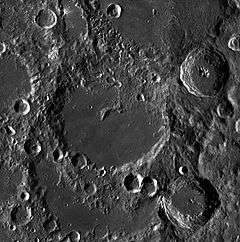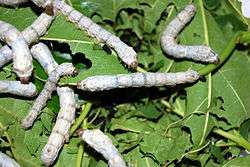Chang'e 4
| Mission type | Lander, Lunar rover |
|---|---|
| Operator | CNSA |
| Mission duration | 12 months |
| Spacecraft properties | |
| Launch mass |
Orbiter: 425 kg[1] Lander: 1,200 kg [2] Rover: 120 kg[2] |
| Landing mass | Total: ~1,200 kg; rover: 120 kg |
| Dimensions | Length: 1.5 m, width: 1.0 m, height: 1.0 m [3] |
| Start of mission | |
| Launch date |
Orbiter: 20 May 2018 Lander & rover: December 2018 |
| Rocket | Long March 3B [4][5] |
| Lunar rover | |
| Landing date | December 2018 |
| Landing site |
Crater Von Kármán[6] in the South Pole-Aitken Basin[7] |
Chang'e 4 (Chinese: 嫦娥四号; pinyin: Cháng'é sìhào) is a planned Chinese lunar exploration mission, to be launched in December 2018, that will incorporate an orbiter, a robotic lander and rover. Chang'e 4 will be China's second lunar lander and rover. It was built as a backup to Chang'e 3, as Chang'e 2 was to Chang'e 1. Following the successful landing of the Chang'e 3 mission, the configuration of Chang'e 4 will be adjusted to meet new scientific objectives. Like its predecessors, the spacecraft is named after Chang'e, the Chinese Moon goddess.
Overview
The Chang'e 4 mission was first scheduled for launch in 2015 as part of the second phase of the Chinese Lunar Exploration Program[8][9] but the adjusted objectives and design of the mission imposed delays, and it is currently scheduled for launch in December 2018.[10] This mission will attempt to determine the age and composition of an unexplored region of the Moon, as well as develop technologies required for the later stages of the program.[11]
The Chinese Lunar Exploration Program has started to incorporate private investment from individuals and enterprises for the first time, a move aimed at accelerating aerospace innovation, cutting production costs, and promoting military-civilian relationships.[12] After Chang'e 4, China will follow with a series of other robotic lunar missions that will build towards an attempted human landing in the early 2030s.[13][1]
Components
Queqiao relay
Since Chang'e 4 is planned to land on the far side of the Moon,[14] CNSA first launched the Queqiao (Chinese: 鹊桥; pinyin: Quèqiáo) communication relay satellite to Earth–Moon L2 point on 20 May 2018[15] to relay commands and data between the lander/rover and the Earth station.[16][17] The relay satellite has a mass of 425 kg, and it will use a 4.2-meter antenna to receive X band signals from the lander and rover, and relay them to Earth control on the S band.[18]
Lander and rover
The lander and rover are expected to be launched six months after the launch of the relay satellite, toward the end of 2018. It will be the first landing on the lunar far side, an unexplored region of the Moon called South Pole-Aitken Basin,[7] a vast basin in the southern hemisphere of the far side which extends from the South Pole to Aitken crater.[19]
Landing site

The proposed landing site is the crater Von Kármán[6] (180 km diameter) in the South Pole-Aitken Basin on the far side of the Moon. Regarding its composition, it contains about 10% by weight iron oxide (FeO) and 4-5 parts per million of thorium,[6] which has been used as a replacement for uranium as nuclear fuel on several thorium reactors.
Science objectives
The science objectives include: [20]
- To measure lunar surface temperature with time
- Measure the chemical compositions of lunar rocks and soils
- Carry out low-frequency radio astronomical observation and research
- Identify the structure of cosmic rays
- Observe the solar corona, investigate its radiation characteristics and mechanism, and to explore the evolution and transport of coronal mass ejection (CME) between the Sun and Earth.
Science payloads
The communications relay satellite, orbiting microsatellites, lander and rover will each carry scientific payloads. The relay satellite will perform radio astronomy,[21] whereas the lander and rover will study the geophysics of the landing zone.[22][1][6] These payloads are, in part, supplied by international partners in Sweden, Germany, the Netherlands and Saudi Arabia.[23]
- Relay satellite
The primary function of the Queqiao relay satellite, which is being deployed in a halo orbit around the Earth-Moon L2 point, is to provide continuous communications between Earth and the lander on the far side of the Moon.[24][17] Additionally, this satellite will host the Netherlands-China Low-Frequency Explorer (NCLE),[25] an instrument which will perform astrophysical studies in the unexplored radio regime of 80 kHz to 80 MHz from translunar locations.
- Microsatellites
As part of the Chang'e 4 mission, two microsatellites (45 kg each) named Longjiang-1 and Longjiang-2 will be deployed into lunar orbit to observe the sky at very low frequencies (1 MHz-30 MHz), corresponding to wavelengths of 300m–10m, with the aim of studying energetic phenomena from celestial sources.[26][27][17] Due to the Earth's ionosphere, no observations in this frequency range has been done in Earth orbit,[27] offering potential breakthrough science.[11]
- Lander
The lander and rover will carry scientific payloads to study the geophysics of the landing zone, with a very limited chemical analysis capability.[22][1][6]
The Lander is equipped with the following payloads:

- Landing Camera (LCAM)
- Terrain Camera (TCAM)
- Low Frequency Spectrometer (LFS) [26] to research solar bursts.
- Lunar Lander Neutrons and Dosimetry (LND), a neutron dosimeter developed by Kiel University in Germany.[28]
- In addition, the lander will carry a container with seeds and insect eggs to test whether plants and insects could hatch and grow together.[1] The experiment includes seeds of potatoes and Arabidopsis thaliana, as well as silkworm eggs. If the eggs hatch, the larvae would produce carbon dioxide, while the germinated plants would release oxygen through photosynthesis. It is hoped that together, the plants and silkworms can establish a simple synergy within the container.[1] In 1982, the crew of the Soviet Salyut 7 space station grew some Arabidopsis, thus becoming the first plants to flower and produce seeds in space. They had a life span of 40 days.[29]
- Rover
- Panoramic Camera (PCAM) [26]
- Lunar penetrating radar (LPR), is a ground penetrating radar[26]
- Visible and Near-Infrared Imaging Spectrometer (VNIS), for imaging spectroscopy
- Advanced Small Analyzer for Neutrals (ASAN), is an energetic neutral atom analyzer provided by the Swedish Institute of Space Physics (IRF). It will reveal how solar wind interacts with the lunar surface and perhaps even the process behind the formation of lunar water.[28]
References
- 1 2 3 4 5 6 China Prepares for Breakthrough Chang'e 4 Moon Landing in 2018. Sputnik News, 31 December 2017.
- 1 2 Chang'e 3, 4 (CE 3, 4). Gunter Dirk Krebs, Gunter's Space Page.
- ↑ This is the rover China will send to the 'dark side' of the moon. Steven Jiang, CNN News. 16 August 2018.
- ↑ Chang'e-4: Far side of the Moon lander and rover mission to launch in December. Global Times, 18 June 2018.
- ↑ Launch Schedule 2018. SpaceflightNow, 18 September 2018.
- 1 2 3 4 5 China’s Journey to the Lunar Far Side: A Missed Opportunity? Paul D. Spudis, Air & Space Smithsonian. 14 June 2017.
- 1 2 Ye, Peijian; Sun, Zezhou; Zhang, He; Li, Fei (2017). "An overview of the mission and technical characteristics of Change'4 Lunar Probe". Science China Technological Sciences. 60 (5): 658. doi:10.1007/s11431-016-9034-6.
- ↑ "Ouyang Ziyuan portrayed Chang E project follow-up blueprint". Science Times. 2011-12-09. Retrieved 25 June 2012.
- ↑ "China's Moon rover awake but immobile". Nature Publishing Group. 2013-03-19. Retrieved 25 March 2014.
- ↑ Long March 4C sends Chang'e 4 relay satellite toward Moon. Tomasz Nowakowski, Spaceflight Insider. 21 May 2018.
- 1 2 China’s Moon Missions Are Anything But Pointless. Paul D. Spudis, Air & Space Smithsonian. 3 January 2017.
- ↑ "China Outlines New Rockets, Space Station and Moon Plans". Space. 2015-03-17. Retrieved 2015-03-27.
- ↑ China’s moon mission to boldly go a step further. Stuart Clark, The Guardian 31 December 2017.
- ↑ "China aims for Moon's far side". BBC. 9 Sep 2015.
- ↑ China Launching Relay Satellite Toward Moon's Far Side Sunday. Mike Wall Space. 18 May 2018.
- ↑ Emily Lakdawalla (2016-01-14). "Updates on China's lunar missions". The Planetary Society. Retrieved 2016-04-24.
- 1 2 3 Jones, Andrew (24 April 2018). "Chang'e-4 lunar far side satellite named 'magpie bridge' from folklore tale of lovers crossing the Milky Way". GBTimes. Retrieved 2018-04-28.
- ↑ Xu, Luyan (2018-05-19). Chang'e 4 relay satellite, Queqiao: A bridge between Earth and the mysterious lunar farside. The Planetary Society, 19 May 2018. Retrieved on 2018-05-20 from http://www.planetary.org/blogs/guest-blogs/2018/0519-change-4-relay-satellite.html.
- ↑ "China Plans First Ever Landing On The Lunar Far Side". Space Daily. 22 May 2015.
- ↑ To the Far Side of the Moon: China's Lunar Science Goals. Leonard David, Space. 9 June 2016.
- ↑ Chang'e 4 Relay. Gunter Dirk Krebs, Gunter's Space Page.
- 1 2 Plans for China's farside Chang'e 4 lander science mission taking shape. Emily Lakdawalla, The Planetary Society, 22 June 2016.
- ↑ Andrew Jones (11 January 2018). "Testing on China's Chang'e-4 lunar far side lander and rover steps up in preparation for launch". GBTimes.
- ↑ Chang'e 4 Relay. Gunter Dirk Krebs, Gunter's Space Page.
- ↑ "Netherlands-China Low-Frequency Explorer (NCLE)". ASTRON.
- 1 2 3 4 The scientific objectives and payloads of Chang'E−4 mission. Yingzhuo Jia, Yongliao Zou, Jinsong Ping, Changbin Xue, Jun Yan, Yuanming Ning. Planetary and Space Science. 21 February 2018. doi:10.1016/j.pss.2018.02.011
- 1 2 Chang'e-4 lunar far side mission to carry microsatellites for pioneering astronomy. Andrew Jones, GB Times. March 2018.
- 1 2 Andrew Jones (16 May 2016). "Sweden joins China's historic mission to land on the far side of the Moon in 2018". GBTimes.
- ↑ "First species of plant to flower in space". Guinness World Records. Retrieved 2017-03-10.


.png)